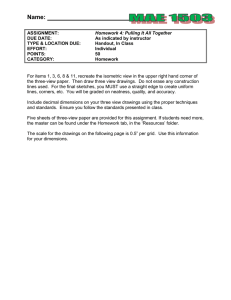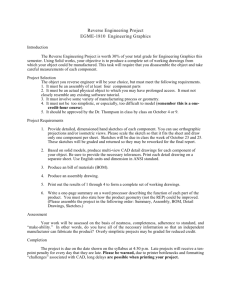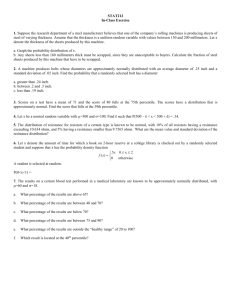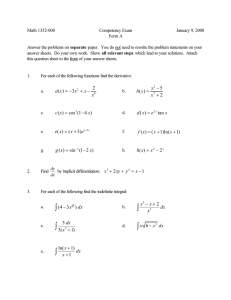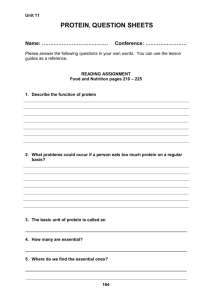FINAL DESIGN / PLANNING PROJECT—EVALUATION CRITERIA
advertisement
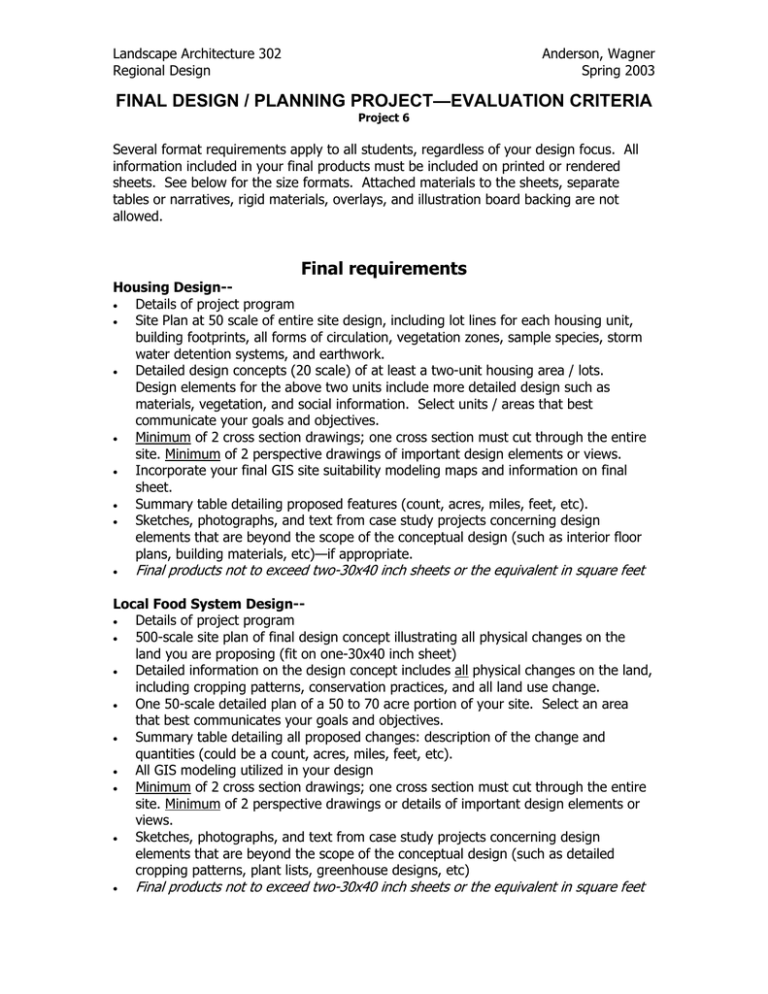
Landscape Architecture 302 Regional Design Anderson, Wagner Spring 2003 FINAL DESIGN / PLANNING PROJECT—EVALUATION CRITERIA Project 6 Several format requirements apply to all students, regardless of your design focus. All information included in your final products must be included on printed or rendered sheets. See below for the size formats. Attached materials to the sheets, separate tables or narratives, rigid materials, overlays, and illustration board backing are not allowed. Final requirements Housing Design-• Details of project program • Site Plan at 50 scale of entire site design, including lot lines for each housing unit, building footprints, all forms of circulation, vegetation zones, sample species, storm water detention systems, and earthwork. • Detailed design concepts (20 scale) of at least a two-unit housing area / lots. Design elements for the above two units include more detailed design such as materials, vegetation, and social information. Select units / areas that best communicate your goals and objectives. • Minimum of 2 cross section drawings; one cross section must cut through the entire site. Minimum of 2 perspective drawings of important design elements or views. • Incorporate your final GIS site suitability modeling maps and information on final sheet. • Summary table detailing proposed features (count, acres, miles, feet, etc). • Sketches, photographs, and text from case study projects concerning design elements that are beyond the scope of the conceptual design (such as interior floor plans, building materials, etc)—if appropriate. • Final products not to exceed two-30x40 inch sheets or the equivalent in square feet Local Food System Design-• Details of project program • 500-scale site plan of final design concept illustrating all physical changes on the land you are proposing (fit on one-30x40 inch sheet) • Detailed information on the design concept includes all physical changes on the land, including cropping patterns, conservation practices, and all land use change. • One 50-scale detailed plan of a 50 to 70 acre portion of your site. Select an area that best communicates your goals and objectives. • Summary table detailing all proposed changes: description of the change and quantities (could be a count, acres, miles, feet, etc). • All GIS modeling utilized in your design • Minimum of 2 cross section drawings; one cross section must cut through the entire site. Minimum of 2 perspective drawings or details of important design elements or views. • Sketches, photographs, and text from case study projects concerning design elements that are beyond the scope of the conceptual design (such as detailed cropping patterns, plant lists, greenhouse designs, etc) • Final products not to exceed two-30x40 inch sheets or the equivalent in square feet Landscape Architecture 302 Regional Design Anderson, Wagner Spring 2003 Institutional Design-• Details of project program • Results of field inventory and assessment work • Site Plan at 50 scale of entire site (or the smallest scale possible on one 30x40 sheet) • Detailed design concepts at 20 scale of all proposed changes, including vegetation with sample species, constructed elements, and earthwork changes needed to accomplish your design • Minimum of 2 cross section drawings; one cross section must cut through the entire site. Minimum of 2 perspective drawings of important design elements. • Runoff calculations (limit to Q=CIA) for proposed design and one other earlier time period (at discretion of your instructor) • All storm water detention or conveyance calculations necessary to size site elements. • Sample vegetation species list • Summary table detailing proposed features (count, acres, miles, feet, etc). • Sketches, photographs, and text from case study projects concerning design elements that are beyond the scope of the conceptual design (such as plant lists, construction details of structures or other constructed elements, etc) • Final products not to exceed two-30x40 inch sheets or the equivalent in square feet Landscape Change Assessment-• Details of project program • Detailed communication of the change you were assessing—use separate maps or other methods as necessary to compare and contrast conditions over time, accompanied by-• A summary table (or other organizational method) quantifying the changes you measured. Use appropriate measure units—count, acres, feet, miles, percentages, etc. • Summary table illustrating the relationship between the changes you measured and the additional elements you individually assessed (soil types, land cover changes, riparian corridor…) • Clear description of the methods you used to measure these changes and the further analysis of these changes—this will be particularly important for the outside reviewers. This shouldn’t be in written paragraph form—use diagrams, etc to communicate. • Final products not to exceed two-30x40 inch sheets or the equivalent in square feet CONSIDER THE USE OF A DIGITAL RESPONSE FOR YOUR FINAL PRODUCTS VIA A PRINTED POSTER. BAKER LAB IN AGRONOMY (4-4418) PRINTS LARGE-SCALE COLOR POSTERS (FROM 10" TO 54" WIDE AND ANY LENGTH) FROM DIGITAL FILES. THE COST WAS $2/SQUARE FOOT FOR THE LEAST EXPENSIVE PAPER--CHECK CURRENT PRICES. YOU WOULD NEED TO ACCOMMODATE THEIR WAITING LIST FOR PRINTING--SO LAST MINUTE RUSHES ARE NOT LIKELY TO BE ACCOMODATED. THEY USUALLY PRINT FROM A POWERPOINT SLIDE FILE. HOWEVER THEY ARE FLEXIBLE ABOUT USING OTHER SOFTWARE. YOU MAY NEED TO LOAD THE SOFTWARE INTO THEIR COMPUTER IF YOU USE SOMETHING OTHER THAN POWERPOINT. REMEMBER THAT YOU CAN EDIT IMAGES, MAPS, PHOTOS IN ILLUSTRATOR OR PHOTOSHOP AND IMPORT THEM INTO POWERPOINT.

